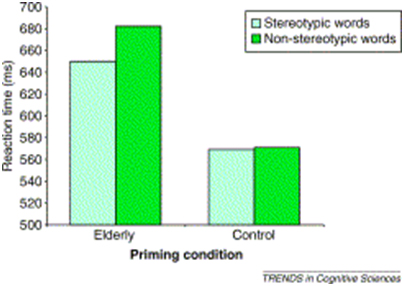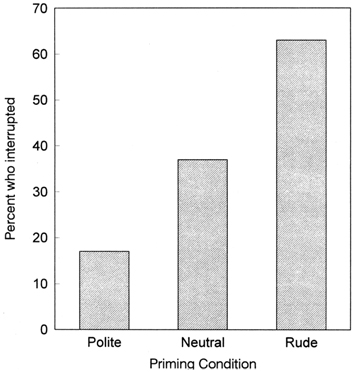Priming: the best anti-aging cream
In their 1996 experiment, Automaticity of Social Behavior: Direct Effects of Trait Construct and Stereotype Activation on Action, these three NYU researches tested whether or not subconscious priming can directly affect behavior.
Subconscious priming is a method in which the experimenter presents the participant with an initial presentation of a stimulus and then makes a series of seemingly unrelated observations to see if the idea implanted behind the stimulus had any subconscious affect on the participant’s actions after being primed. It’d be like asking you about the weather, and then asking to recount an emotional trauma.
In the first experiment, some participants were primed with rude words and concepts while others were primed with politeness-related stimuli. The rude-primed and polite-primed participants then had a facilitated conversation with each other about an outwardly unrelated topic. The experimenters, hypothesizing that participants may be less polite after exposure to ‘rude-primes’, observed to see who interrupted who.
Researchers found that the individuals who had been primed with rude stimuli interrupted the experimenter and their peers far more frequently than either the control group or the participants who had been primed with polite stimuli (see chart below):
In the second experiment, participants were either primed with elderly sentences and phrases (i.e. “I went to Florida.”, “Bingo is on Wednesday.”, “I’m seeing more wrinkles.” etc…) or neutral phrases (I.e. “There is a cat.”), then given an unrelated activity in another room, as experimenters observed how long it took them to walk down the hallway.
In this experiment, Researchers found that participants primed with “old” phrases walked more slowly down the hallway afterwards by an overall average of 7 seconds (see chart below).
 In the third experiment, participants were primed with pictures of violent African-American stereotypes and then had a conversation about an unrelated subject with the experimenter. In short, the experimenter was testing whether or not people could be swayed towards more racist tendencies subconsciously, just by showing participants a picture of a black man waving a gun around.
In the third experiment, participants were primed with pictures of violent African-American stereotypes and then had a conversation about an unrelated subject with the experimenter. In short, the experimenter was testing whether or not people could be swayed towards more racist tendencies subconsciously, just by showing participants a picture of a black man waving a gun around.
The third study revealed that participants primed with African-American stereotypes reacted with more hostility to a annoying request than the control group.
In all three cases, priming was shown to have a significant effect on individual behavior. In fact, Bargh’s results were so influential and significant that he developed many of these themes into a series of articles on the subconscious mind.
So, once again behavioral science has deduced some counter-intuitive though truly remarkable premises:
1) Our behavior at present can be subconsciously affected by all kinds of stimuli around us (phrases, words, images, smiles, conversations).
2) We are associatively influences by such stimuli to feel a particular emotion or be aroused to a particular mood (as participants in the third experiment began to associate aggressive African-Americans with their own aggression).
3) If we want to look and feel younger, we just have to prime ourselves with words like “toy”, “play” and “energy”, remember to forget that we’re experimenting on ourselves, eat sugar cereal while staring at the back of the box, run down every hallway, and burgeon down staircases with reckless abandon. See, my mom wasn’t totally wrong.
Bargh, however, makes his own conclusions, in a much more erudite fashion:
“Experimental social psychologists have amassed a large body of findings over the past three decades suggesting that social knowledge is automatically activated in memory during the natural course of perception. That is, while people are seeing and listening to the world around them, social knowledge that corresponds to perceived stimuli is spontaneously and immediately activated in memory without people’s awareness or intention. This research has also shown that automatically activated information then shapes and guides people’s impressions, judgments, feelings and intentions without people being aware that such influence is occurring.”(Bargh + Ferguson 2003)
While the contents of these experiment might be controversial, the methodology is sound. Bargh’s emotional studies challenge us to ask which of our perceptions about an object or person are “up to us” (in the sense that we are free to see the world we want to see), and which of our perceptions are “us seeing the world as we’re supposed to see it.” What does this say about who’s actually making decisions in our lives? Who gets to frame the ‘supposed to’ anyway? It’s Descartes paradox of being all over again…
Priming is not just for psychologists and researchers however; it’s an incredibly useful tool for marketers because it allows for a controlled flow of emotional information that’s guaranteed to be interpreted by the subconscious mind.
Marketers and advertisers stress about perfection; visual presentations, commercial advertisements, even financial reports – they all have to look just right. And while you’ve been spending so much time focused on seamless design and professional looks, you forgot about its flow – the subconscious emotional content of a presentation is integral to its success with any campaign.
Priming isn’t just a method of affecting people subconsciously; a nice elegant chain of subconscious messages woven into a sleek advertising campaign would not only make your customers think that they want your product; it will make them believe it. And when you achieve this, you win the marketing game.


Trackbacks/Pingbacks